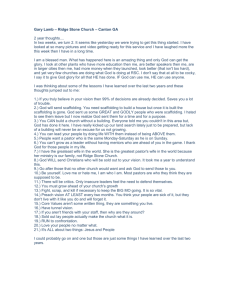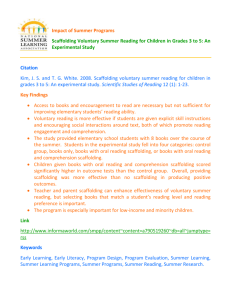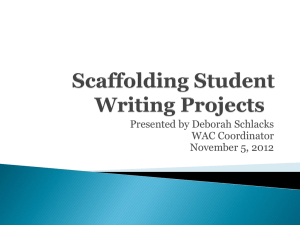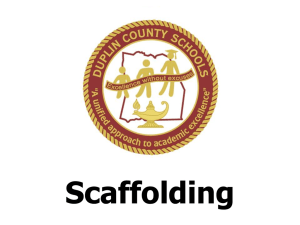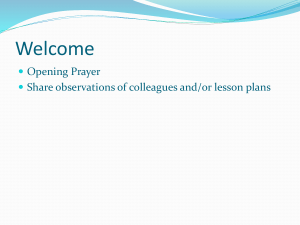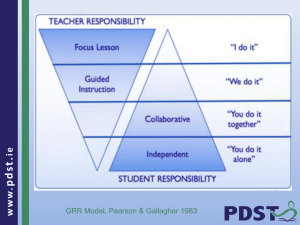Document 10466966
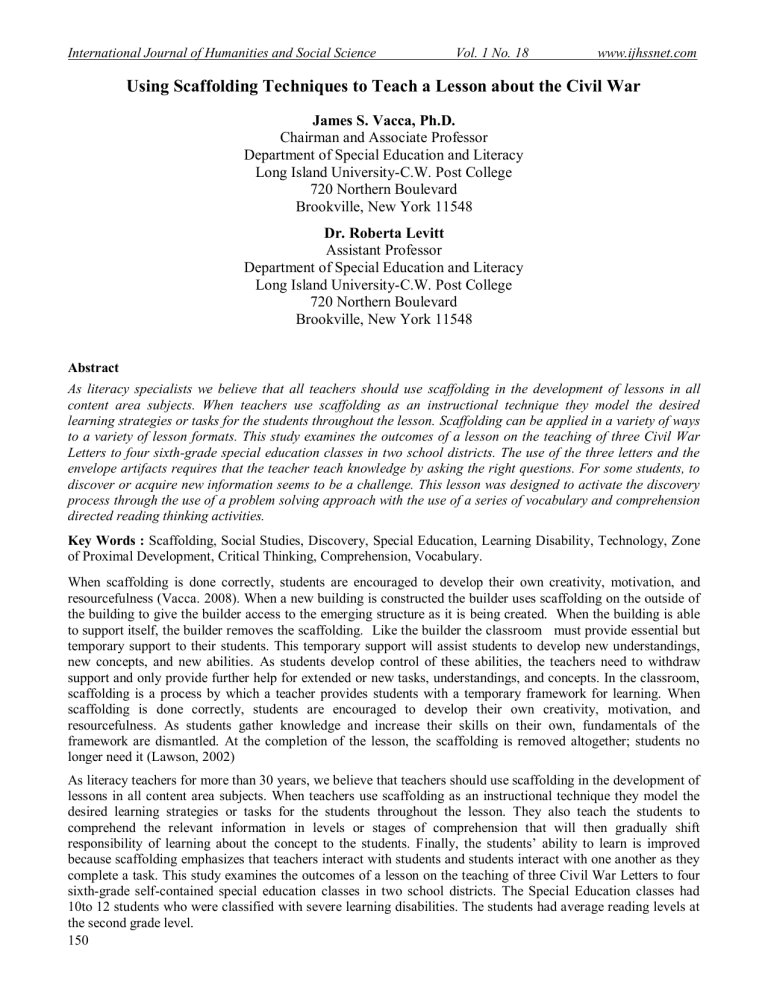
International Journal of Humanities and Social Science Vol. 1 No. 18 www.ijhssnet.com
Using Scaffolding Techniques to Teach a Lesson about the Civil War
James S. Vacca, Ph.D.
Chairman and Associate Professor
Department of Special Education and Literacy
Long Island University-C.W. Post College
720 Northern Boulevard
Brookville, New York 11548
Dr. Roberta Levitt
Assistant Professor
Department of Special Education and Literacy
Long Island University-C.W. Post College
720 Northern Boulevard
Brookville, New York 11548
Abstract
As literacy specialists we believe that all teachers should use scaffolding in the development of lessons in all content area subjects. When teachers use scaffolding as an instructional technique they model the desired learning strategies or tasks for the students throughout the lesson. Scaffolding can be applied in a variety of ways to a variety of lesson formats. This study examines the outcomes of a lesson on the teaching of three Civil War
Letters to four sixth-grade special education classes in two school districts. The use of the three letters and the envelope artifacts requires that the teacher teach knowledge by asking the right questions. For some students, to discover or acquire new information seems to be a challenge. This lesson was designed to activate the discovery process through the use of a problem solving approach with the use of a series of vocabulary and comprehension directed reading thinking activities.
Key Words : Scaffolding, Social Studies, Discovery, Special Education, Learning Disability, Technology, Zone of Proximal Development, Critical Thinking, Comprehension, Vocabulary.
When scaffolding is done correctly, students are encouraged to develop their own creativity, motivation, and resourcefulness (Vacca. 2008). When a new building is constructed the builder uses scaffolding on the outside of the building to give the builder access to the emerging structure as it is being created. When the building is able to support itself, the builder removes the scaffolding. Like the builder the classroom must provide essential but temporary support to their students. This temporary support will assist students to develop new understandings, new concepts, and new abilities. As students develop control of these abilities, the teachers need to withdraw support and only provide further help for extended or new tasks, understandings, and concepts. In the classroom, scaffolding is a process by which a teacher provides students with a temporary framework for learning. When scaffolding is done correctly, students are encouraged to develop their own creativity, motivation, and resourcefulness. As students gather knowledge and increase their skills on their own, fundamentals of the framework are dismantled. At the completion of the lesson, the scaffolding is removed altogether; students no longer need it (Lawson, 2002)
As literacy teachers for more than 30 years, we believe that teachers should use scaffolding in the development of lessons in all content area subjects. When teachers use scaffolding as an instructional technique they model the desired learning strategies or tasks for the students throughout the lesson. They also teach the students to comprehend the relevant information in levels or stages of comprehension that will then gradually shift responsibility of learning about the concept to the students. Finally, the students’ ability to learn is improved because scaffolding emphasizes that teachers interact with students and students interact with one another as they complete a task. This study examines the outcomes of a lesson on the teaching of three Civil War Letters to four sixth-grade self-contained special education classes in two school districts. The Special Education classes had
10to 12 students who were classified with severe learning disabilities. The students had average reading levels at the second grade level.
150
The Special Issue on Business and Social Science © Centre for Promoting Ideas, USA
Scaffolding can be applied in a variety of ways to a variety of ways to a variety of lesson formats. The use of the three letters and the envelope artifacts requires that the teacher teach knowledge by asking the right questions. For some students, to discover or acquire new information seems to be a challenge. This lesson was designed to activate the discovery process through the use of a problem solving approach with the use of a series of vocabulary and comprehension directed reading thinking activities. For some students, to discover or acquire new information seems to be a challenge. This Civil War lesson was designed to activate the discovery process by using a problem-solving approach with a series of vocabulary- and comprehension-directed reading and thinking activities. The lesson was scaffolded according to Vygotsky’s four stages for the ZPD and Herber.
How teachers interact with students and how students interact with one another as they complete a task is important to students' ability to perform an activity. Scaffolding is an instructional technique whereby the teacher models the desired learning strategy or task and then gradually shifts responsibility to the students. This type of interaction is consistent with Vygotsky’s (1934/1978) belief that learning and cognitive development are culturally and socially based. This means, moreover, that learning is a social process and not an individual one, and it occurs when students interact with their teacher and with one another in the classroom.
Although Vygotsky (1934/1978) did not use the term scaffolding, it does have a theoretical basis in his description of the Zone of Proximal Development (ZPD). He defined the ZPD as the distance between the actual development level of the learner, as determined by independent problem solving, and the level of potential development, as determined through problem solving under teacher guidance and interaction and collaboration with more capable student peers (Doolittle, 1997).The ZPD is represented in a model with four stages (Tharp &
Gallimore, 1988). This model illustrates the scaffolding process, and it represents the relationship between teacher and student interaction in group settings. Table 1 show how the four ZPD stages relate to the three levels of comprehension defined by Herber and Herber (1993).
In stage 1 of the ZPD or scaffolding, there is frequent teacher and student interaction because the teacher needs to provide the student with the literal facts, details, key names, and dates related to the concepts or ideas being taught. In stage 2, students work together in small groups, and the teacher provides them with activities that encourage interpretation through metacognition and guided practice. In stages 3 and 4, the students continue to work together and independently while applying the information that they have learned to new ideas and concepts.
Insert Table 1 about here
Using this framework as a guide, we extended the implementation ideas to include different types of text about the Civil War that social studies teachers are likely to use in the classroom.
How Can Scaffolding Be Applied to the Teaching a Social Studies Lesson about three Civil War Letters
The lesson was based on a series of three letters written by a fifteen year old soldier to his parents in 1862. The use of the three letters and the envelope artifacts required that the teacher teach knowledge by asking the right questions. For some learning disabled students, to discover or acquire new information seems to be a challenge.
This lesson was designed to activate the discovery process through the use of a problem solving approach with the use of a series of vocabulary and comprehension directed reading thinking activities.
LESSON OBJECTIVES
The students will be able to:
• Observe and describe what they see as they observe the envelope and letters.
• Develop and ask a series of additional questions about the artifacts and to seek answers about what they want to know.
• Compare and contrast information contained in the letters and the person who wrote each letter.
• Make inferences, conclusions and generalizations about the letters based on the Information the students have gathered.
LESSON INTRODUCTION
The lesson began with a presentation of a story about the Civil War Soldier who wrote the letters. The soldier’s name was Galutia York and he was the oldest son of a farm family from Hubbardsville, New York. In 1862
President Lincoln called for 300,000 volunteers to enlist in the Union Army and in that summer Galutia enlisted.
151
International Journal of Humanities and Social Science Vol. 1 No. 18 www.ijhssnet.com
He was 19 years old when he joined Company G of the 114th New York State Volunteer Infantry. On September
6, 1862, the 114th left Norwich, in Chenango County, for Binghamton, and from there they went to Baltimore,
Maryland. They served in the VIII Corps in the Defense of Baltimore until early November when the regiment sailed for Fort Monroe at the mouth of the James River in Virginia. When General Banks' Expedition was formed in December, the 114th sailed for New Orleans, Louisiana. Galutia stayed behind at Chesapeake Hospital until
February of 1863. At that time he rejoined his comrades in Louisiana. Galutia died on May 20, 1863, in Berwick
City. He had never been in a shooting battle, but the enemy he fought was just as deadly as any Rebel sharpshooter – disease (Greenhagen, 2009).
The students then observed the following envelope and letter page artifact samples that were projected on a smart board screen (Figure 1).
Insert Figure 1 about here
ACTIVITIES AND PROCEDURES
Activity 1: HIGH LEVEL OF TEACHER INTERACTION WITH STUDENTS –ZPD STAGE 1-LITERAL LEVEL
Directions: The students were divided into small groups of four. The following Written Document Analysis
Worksheet was next distributed to the students. Each group of students was asked to discuss among themselves each of the items on the worksheet. Civil War Written Document Analysis Worksheet Discussion Activity
Worksheet (From Pappas, 2010) http://www.edteck.com/dbq/index.htm
)
Written Document Analysis Worksheet
1. TYPE OF DOCUMENT (s) (Check one):
___ Newspaper
_X Letter
___ Patent
___ Memorandum
___ Map
___ Telegram
___ Press release
___ Report
___ Advertisement
___ Congressional record
___ Census report
_ X_ Other (envelope)
`2. UNIQUE PHYSICAL QUALITIES OF THE DOCUMENTS (Check one or more):
_ X _ Interesting letterhead
_X_ Handwritten
___ Typed
_ X _ Seals
___ Notations
___ "RECEIVED" stamp
_ _X _ Other ( Picture, Stamps )
3. DATE (S) OF DOCUMENTS: October 16,
1862 ________________________________________
4. AUTHOR (OR CREATOR) OF THE DOCUMENT: Galutia ___________________
POSITION (TITLE): son, soldier- Union
Army ________________________________________
5. FOR WHAT AUDIENCE WAS THE DOCUMENT WRITTEN?
_Written to _________ parents___________________________________________
6. DOCUMENT INFORMATION (There are many possible ways to answer A-E.)
A. List three things the author said that you think are important:
1.
_ date of letter__________________________________________
2.
_address_____________________________________________
3.
_ postmark of letter _____________________________________
B. Why do you think this document was written?
__the writer was lonely____________________________________
__the writer wanted his family to know that he was OK_________
152
The Special Issue on Business and Social Science © Centre for Promoting Ideas, USA
C. What evidence in the document helps you know why it was written? Quote from the document.
_____________________________________________________
_____________________________________________________
D. List two things the document tells you about life in the United States at the time it was written:
_____________________________________________________
_____________________________________________________
E. Write a question to the author that is left unanswered by the document:
_____________________________________________________
_____________________________________________________
Activity 2- HIGH LEVEL OF TEACHER INTERACTION WITH STUDENTS –ZPD STAGE 1-LITERAL LEVEL
OF COMPREHENSION
Directions for List-Group-Label: The teacher asked the students to look at the list of Twenty two words and organize the words under five categories that were written on the white board in the front of the classroom. The students were told that the categories related to the three letters they were going to read. The twenty six words listed were
Camp
Guard
Company
Boots
Checkers
Uncle Sam
Money
Sickly
Walnuts
Chestnuts
Onions
Cheese
Soar Throat Johnnycake
Paper Rifle
Photographs
Convulsive Fit
Quarentine
Buried
Government Rations
Coral Ring
The five categories that were written on the white board were:
Military Terms
Recreational Activities
Nutrition
Illness
List Group Label Student Activity
Category/
Vocabulary
Words Military Terms
Camp
Guard
Company
Boots
Rifle
Uncle Sam
Leisure Activities
Money
Paper
Photographs
Checkers
Coral Ring
Nutrition
Onions
Cheese
Johnny Cake
Rations
Walnuts
Chestnuts
Illness
Quarantine
Sickly
Soar Throat
Convulsive Fit
Activity 3TEACHER PROVIDES STUDENTS WITH OPPORTUNITIES FOR GUIDED PRACTICE AND
METACOGNITION –ZPD STAGE 2- INTERPRETIVE LEVEL OF COMPREHENSION
Directions: The teacher reads the following three letters to the students and instructed them to use a colored highlighter to highlight the note the key words that were listed for each letter.
153
International Journal of Humanities and Social Science Vol. 1 No. 18 www.ijhssnet.com
Letter One-October 8, 1862
Camp Belger Oct 8th 1862
Dear Parent
It is with great pleasure that I take this board on my lap to answer your most welcomed letter of the 5th which I received to day I was verry glad to hear from you once more and to hear that you was well you wanted to know if I was well yes I be and have ben eversince I have been hear excepting I had the diarrhoe twaice a little
Uncle Stephen wrote that name on that picture for me I should have wrote it but I caught it just as I was a going on guard and I wanted to send it with his so he wrote it so that's whats the matter yes I have to sleep on the soft side of a board everry night you dont suppose I would --- sleep on the hard side when the soft side comes just as cheap do you you wanted to know if there was any thing that I wanted yes I want a little money to get my boots tapped with that is something that I didnt calculate for for
I suppose that Uncle Sam tapped our boots for us but he dont The soil down hear is verry coarse sand and it wears shoeleather the worst thing Them taps that
George put on are all gone and the bottoms of a good many of their shoes ar all gone I have got money enough to last excepting that ma I want you to get me a pear of good yarn mittens and when I want them I will send for them that
Letter One Continued is all I want you know which way is north south east and west is on the map it is the same on that picture the soldiers stands east and west our company is second from the east you can see some men right in fron of the columns the 6th man is Capt Tucker the 5th man is Sirls and the 4th is Underhill and
I stand pretty near the left flank of our company I am verry thankfull for those letter stamps you send me no there dont no one have to read your letters but myself There is noone any business reading my letters I sing the contryband son the most of any I will sing that for you ma That is bully it is quite sickly now hear ther has 2 died in this regiment and about 20 in the hospital dan has got smart again george davy is quite sick I dont know when we shall be briggaded but not untill we get together again I got a letter from Uncle
John today how do I spend my time when I am not a drilling I spend it in reading writing fixing my cloths playing checkers and setting on my dogs ass well I have wrote about all that I can think of now so good by for this time this from your most affectionate son
Galutia York to Zebulon York
Lucy York
Henry how does flying childer do now write as soon as you get this dont be afraid of long letters
please write as soon as you get this
direct as before
154
The Special Issue on Business and Social Science © Centre for Promoting Ideas, USA
Letter 2-October 24, 1862
Camp Belger Oct 24 1862
Affectionate Brother Henry it is with much pleasure that I take my pen in hand to inform you how I get along and in answer to your most welcomed letter which I received yesterday
I am well as usual and
I hope this will find you the same
I am glad to hear you are all well it is a pretty sickly time around there you must all be carefull and not get the soar throat for I want to see you all when I come home but not knowing when that time will be but I hope it haint far distant we ar on Camp Belger yet and and probably shall stay hear all winter our company was ordered to go yesterday but before we could get rigged the order came not to go so we unpaked our napsacks but Capt Tucker was determined to go some where so a part of our company went up and camped out I should have went but I was on guard they went off 5 or 6 miles Henry I wish you could be hear a little while I guess that I shall hire a horse and come home next Saturday night and get back Monday morning tell ma I was verry thankfull for that paper that she sent to me but sumebody stole it before
I got a chance to read it if you could get another one pretty handy
I wish you would send it on
I wish I could get a chance to pick up some walnuts and chestnuts and send home but I cannot get off the ground now without an officer is Pa agoing to send me a box of stuff if he is tell him to do down to
Warrens and tell him I want him to send me some of the best cheese he has got send me some butter and get a few good
Letter 2 Continued apples I want some for myself and some for send me a few onions they are the best thing that I can get to eat to keep away sickness
I cant get an onion short of a cent a piece send me some cake and a good sweetened johnnycake Dan has wrote to Abey I dont know what he has sent for but you can put them in so we can tell them apart. put in a little peice of maple sugar
I dont think of anything more that I want now
Capt Tucker
Tell Pa if he will send it I will stand the charges when
I get home there was 2 boys run away the other day they was taken in Pennsylvania and brought back they are in the guard house now waiting their trial one of them will have to be shot I guess for it is the
and third time he has run away
Henry I have got a bully good rifle it will carry a ball 500 yds
I think you will make a fortune taking photographs I should not think you would wait untill the ___ work was done I think the photograph you sent me looked quite natural I have wrote about all that I can think of this time so I must close you must write soon this from your ever loving brother
Galutia York to Henry York
H.C.Y.
G.H.Y.
I guess Pa got one foot out of the traces when he sold his hops didnt he direct as before
155
International Journal of Humanities and Social Science Vol. 1 No. 18 www.ijhssnet.com
Letter 3- May 16, 1863
Berwick City May 16, 1863
Sister
Dear Brother Nephews & Nices a sad duty devolves on me to announce to you that
Letter 3 Continued little things as can be enclosed in papers & letters I will send, if you wish the other things boxed & sent please let me know the climate here did not seem to agree with him in the morning he would seem
Galutia is no more he died on the 14 inst at 2 oc P.M. he had been aboutas usual until the
13th at noon he was lying in my tent and seemed to sleep well when all at once he was seized with a sort of convulsive fit the Dr gave him some medicine which relieved him, after he came out of it he told me he had one spell similar to this at quarantine he was taken to the hospital over the Bay the same day I told the Dr as near as I could how he had been he often complained of a fluttering in the region of the heart. The next day the
14th I was informed of his death which was entirely unexpected to me. I larn from the nurse who had the care of him also one quite well untill the sun got up hot the 13 he was up much earlyer than usual I was pleased as I thought he would get along as soon as his diaerea could be checked he had but a poor appetite and could not bear government rations and bought most he eat such as eggs mackeral crackers & cheese. after he came out of the fit he told me he had been home and seen you all. after this as
I was watching him and keeping the flies of saye he Uncle Steve I am dieing I took his hand and says I no I think not in a few minutes he felt better I was in hope of his recovery, but alas such is life his death has cast a gloom over all of the boys in Co I 114 whose bed was near
Galutias that he rested well through the night & felt well in the morning his dinner was brought him. he made the remark it was the best tea he had tasted since he had been in the service he sat up in bed with the cup of tea in his hand all at once he let the cup fall who knew him there are but 6 of our Co in camp here they wish me to say to you that you have their heart felt sympathy all who knew him but to love him. Alas how many hearts have been made to bleed by this cursed war how many places are left vacant God grant peace may soon crown the effort of the and leaned over back and was dead were performed after the Episcopal form the place he is buried is a beautiful elevation on the bank of the river it is a dry sandy spot
Union armies if ever I return home it will be with sorrow because one is not, who left home with boyiant hope with me. you will please answer this where quite a number of soldiers are buried immediately and tell me how you also many citizens it is the most lovely spot I have seen in Louisiaan a smooth plain pine board stands at his head bearing this inscription are getting along. let not this shock overcome you. you have my most heartfelt sympathy as ever your affectionate
Brother
Stephen Tuttle G. York Co. G 114 N.Y.S.V. aged 19 years I have been this minute knowing that everything concerning him interests you
I have done as I should with anyone to do by judson I have done the same by by one that
I have by the other I have endeavoured to make him happy as possible he has lacked for nothing in my power to help him to Enclosed is a coral ring taken from his finger after he died the ___ master has possession of his things in time they will be seen to such
156
The Special Issue on Business and Social Science © Centre for Promoting Ideas, USA
Activity 4- MORE SMALL GROUP STUDENT INTERACTION AND LESS DIRECT TEACHER
INVOLVEMENT –STAGE 3 & 4-APPLIED LEVEL LEVEL OF COMPREHENSION
Directions: The students were divided into small groups of four. The students are asked to edit small chuncks of the letters using an editing checklist (Figure 2) and rewrite the letter chunk and be prepared to read their final copies to their classmates. Each student was assigned one of the following jobs: (1) One student served as the writer of the group corrections; (2) One student was the reader of the group’s revised text; and (3) Two student wrote the revisions on the smart board. Figure 3 is a sample of the student revisions for letter one.
Student Revisions of Letter One
Insert Figure 2 about here
Insert Figure 3 about here
Reflections
It was interesting to observe how the students interacted with each other throughout the lesson. They were very active with each task and very little time was wasted. In addition, the use of the Smart board gave the students an opportunity to immediately display their work. By the conclusion of the lesson the Special Education students not only knew the information that was most important to the Civil War letters, but also they had no difficulty relating to the boy soldier who wrote these letters. Comments from the students like “this was fun” and “we want to do more” were heard after the lesson was concluded. The teacher and teacher aides who assisted the students during the lesson said that they were excited about the activities and the pace of the lesson. They said they want to use more scaffolding techniques in developing other classroom lessons. Most of all the lesson demonstrated that scaffolding techniques are needed to effectively teach content area subject materials to elementary and middle school students in self-contained Special education classes.
Final thoughts
Based on our more than three decades of teaching Literacy and Special Education, we believe that there are many positive benefits for teachers in using the Smart board in combination with scaffolding techniques in the development of lessons in all content area subjects. The Smart board helps the students interact immediately with each other, the content and activities of the lesson and with the internet, if needed. In addition, the use scaffolding as instructional techniques helps the teachers model the desired learning strategies or tasks for the students throughout the lesson. They also teach the Special Education students to focus on and discuss the germane information in levels or stages of comprehension that will then gradually transfer responsibility of learning about the idea to the students. The students learn more about the concept and they communicate more effectively with each other. And finally, with the use of scaffolding techniques it is apparent the students grow in confidence about what they are learning. They also seem to retain the content information over a longer duration of time after the lesson has been taught. and Herber’s three levels of comprehension.
The following are some suggested ways that teachers can improve student learning by using scaffolding in their lessons (Vacca, 2008).
Establish continuity from one task to the next, and, if necessary, repeat some tasks with variations. Most of all make sure that the tasks are connected to one another according to the literal, interpretive, and applied levels of thinking.
Provide contextual support for the learners by encouraging them to explore, access, and discuss the content that they are learning using a variety of different available resources.
Establish rapport with the students and encourage mutual engagement among the learners. Motivate them t o discuss the content with non threatening participation and practice in a positive sharing classroom environment.
Adjust the task procedures depending on actions, contributions, and discussions of the learners.
Observe carefully the learners’ readiness to take over increasing parts of the tasks and then handover the role and responsibility of completing more rigorous tasks to the learners as their skills and confidence with the content increase.
Establish a flow and balance with the skills and challenges of the tasks and make sure that the learners are focused on the tasks at all times and that they are respectful of one another when they are answering questions and discussing the content.
157
International Journal of Humanities and Social Science Vol. 1 No. 18 www.ijhssnet.com
In the Special Education classroom, scaffolding is a process by which a teacher provides students with a temporary framework for learning. When scaffolding is done correctly, students are encouraged to develop their own creativity, motivation, and resourcefulness. As students gather knowledge and increase their skills on their own, fundamentals of the framework are dismantled. At the completion of the lesson, the scaffolding is removed altogether; students no longer need it (Lawson, 2002).
Walqui (2002) maintained that scaffolding can be thought of as three related pedagogical scales:
1.
Providing a support structure to the students to enable certain activities and skills to develop
2.
Carrying out of particular activities in class
3.
Providing assistance in moment-to-moment interaction
Fournier and Graves (2002) use the example of training wheels on a bicycle example of scaffolding. The training wheels are adjustable and temporary and they provide the child with the support the she or he needs while learning to ride a two-wheeler. Without the training wheels learning to pedal, balance, and steer all at one time becomes very difficult, if not impossible for the child. Like the training wheels, scaffolding-aids the child to learn concepts in a supportive, directed, purposeful guided fashion. According to McKenzie (1999) the best lessons always make significant use of scaffolding to organize and support the student investigation or inquiry, to keep students from going too far off the path while seeking "the truth" about whatever issue, problem or question was driving the project. The least successful lessons assume too much about student skills, organizational abilities and commitment and the students are sent off on expeditions with little in the way of structure or guidance. .
McKenzie maintains that there is no appropriate (educational) definition in a dictionary. The term is relatively new for educators, even though the concept has been around for a long time under other names. McKenzie believes that structure is the key word. Without clear structure and precisely stated expectations, and purpose many students are vulnerable to drifting away from what they are supposed to learn. The predicament, according to McKenzie, is how we provide sufficient structure to keep students productive without confining them to strait jackets that destroy initiative, motivation and resourcefulness.
Robb (2003) presents many ideas for using informational texts and artifacts (trade books, letters, newspapers, magazines, or textbooks) in the classroom. The author shows teachers how to engage in responsive teaching and how to scaffold student learning from text. Robb examines and refutes the following four assumptions common to content area reading:
that textbooks are the main information resource,
that lecture and copying notes are great ways to teach new information,
that review questions at the end of each chapter help students study and determine what they understand, and
that students learn to read in the lower grades and don't need reading instruction in intermediate and middle school content subjects.
She describes the following five roadblocks that affect teachers and students when reading and comprehending materials in social studies, science, and math:
(1) student avoidance of textbook reading; (2) student inability to read the textbook; (3) the myth of the concept of learning to read versus reading to learn; (4) the traditions of reading instruction at the intermediate and middle grades (time allocations, too much curriculum to cover; lack of preparation for teaching reading); and (5) the implementation of the Transmission Model of Learning, in which knowledge is transmitted to students through various teacher practices. Robb further suggests that excellent comprehension instruction happens if teachers follow a three-part lesson framework-Getting Ready to Learn, During Learning Instruction, and After Learning
Instruction. In addition she maintains that through lesson plans and vignettes from classroom experiences students become active learners of meaning. The author also maintains that each chapter should conclude with Pause and
Reflect, a time for each student to reflect on classroom teaching practices. This strategy, Robb maintains, reinforces the relationship between that reading is reasoning have with each other. This Show Me, Help Me, and
Let Me scaffolding strategy suggested by Robb and used in with the Civil War lesson was designed to give a gradual release of responsibility from teacher modeling to student independence as students become more proficient at constructing meaning from the materials.
158
The Special Issue on Business and Social Science © Centre for Promoting Ideas, USA
Tables and Figures
Table 1
THE THREE LEVELS OF COMPREHENSION
AND THE STAGES OF THE ZONE
OF PROXIMAL DEVELOPMENT
USE QUESTIONS AT EACH LEVEL OF THINKING
“beyond the lines”
“Students master cognitive strategies and are more independent in their thinking”
APPLIED LEVEL
MORE SMALL GROUP STUDENT
INTERACTION AND LESS DIRECT
TEACHER INVOLVEMENT
–PHASE 3 & 4
“ between the lines”
“Students work together to internalize ideas”
INTERPRETIVE LEVEL
TEACHER PROVIDES
STUDENTS WITH
OPPORTUNITIES FOR GUIDED
PRACTICE AND
METACOGNITION -PHASE 2
“on the page
”
“Assistance provided by more capable others”
LITERAL LEVEL
HIGH LEVEL OF TEACHER
INTERACTION WITH
STUDENTS –PHASE 1
Figure 1
Civil War Envelope (Greehagen, 2009) Sample Letter Page (Greenhagen, 2009)
159
International Journal of Humanities and Social Science Vol. 1 No. 18 www.ijhssnet.com
Figure 2
Editing Checklist
(check each)
Indent Paragraph (s)
Complete Sentences (each has a subject and predicate)
Capitalization
• Do all sentences begin with a capital letter?
• Do all proper nouns begin with capital letters?
Punctuation
• Are periods and commas used correctly?
• Are quotations punctuated correctly?
Verb Usage
• Do all main verbs agree with the subject in person and number?
Are any parts of verb phrases missing or incorrect?
Are verb endings correct?
• Is the verb tense correct?
• Are helping verbs used when needed?
Noun Usage
• Do regular plurals end in “s”?
Are irregular plurals correct?
• Are articles (“a,” “an,” and “the”) used correctly?
• Does every pronoun have a clear referent?
Correct Spelling (Be careful of words that sound the same but have different meanings.)
Descriptive Words
• Are words used that give a picture of what is taking place?
• Are transitional words used?
Word Variety
• Do sentences begin with different words?
• Did the writer use a variety of words in each sentence?
Student Revisions of Letter One
Figure 3
Number 1
Camp Belger Oct 8th , 1862
Dear Parent s,
It is with great _ pleasure that I take this _ board on my lap to answer _ your most welcomed letter _ of the 5th which I received _ to < day .
Number 2 yes I have to sleep on the _ soft side of a board ever r y night ._yY
ou dont suppose I would ---sleep on the hard side when _ the soft side comes just as _ cheap dD o you you want ed to _ know if there was any> thing. To Be continued.
Number 3 yY ou wanted to _ know if there was any thing _ that I wanted .
yY es , I want a _ little money to get my boots > tapped with that is something .
I suppose thought that Uncle Sam _ tapped our boots for us but _ he dont didn’t.
Number 4
I have _ got money enough to last _ except ing that > mamom, I want you _ to get me a p e a i r of good yarn _ mittens . and wW hen I want _ them , I will send for them .
160
The Special Issue on Business and Social Science © Centre for Promoting Ideas, USA
Number 5
I sing with the contrybands _on the most .
of any I will sing that for you mM a . That is bully .i
It is quite sickly now .
I hear therhas
2 died in this regiment _ and about 20 in the hospital ._dD
an has got smart .
again gG eorge _dD avy is quite sick .
Number 6 wW hen I am not a drilling , > I spend it in _ reading , writing , fixing my cloth e s , playing _ checkers , and s e itting on the grass with my dog s.
asswell I have wrote about all that
I can _ think of now .
sS o good by e for this time this fF rom your most affectionate son _ Galutia York to
Zebulon York _ and Lucy York .
REFERENCES
Doolittle, P.E. (1997). Vygotsky’s Zone of Proximal Development as a theoretical foundation for cooperative learning.
Journal on Excellence in College Teaching , 8 (1), 83–103.
Fournier, D. N., & Graves, M. F. (2002). Scaffolding Adolescents' Comprehension of Short Stories: This Article
Describes an Approach to Assisting Seventh-Grade Students' Comprehension of Individual Texts with a
Scaffolded Reading Experience or SRE. Journal of Adolescent & Adult Literacy, 46 (1), 30+. Retrieved
January 30, 2005, from Questia database, http://www.questia.com.
Graves, M. F., & Avery, P. G. (1997). Scaffolding Students' Reading of History. Social Studies , 88 (3), 134-138.
Greenhagen, Sue ,ed. (2009) 114th New York State Volunteer Infantry: A Regimental Archive. Available online at:http://library.morrisville.edu/local_history/sites/114th/
Herber, H.L., & Herber, J.N. (1993). Teaching in content areas with reading, writing, and reasoning . Needham
Heights, MA: Allyn & Bacon.
Lawson, L., (2002), Scaffolding as a Teaching Strategy . [Online] Available: condor.admin.ccny.cuny.edu/~group4/.../Lawson%20Paper.doc (July 2, 2009).
McKenzie, J. (1999 ). Scaffolding for success. From Now On:The Educational Technology Journa l , 9 (4). Retrieved
July 15, 2006, from www.fno.org/dec99/scaffold.html
Mercer, N. (1995). The guided construction of knowledge:Talk among teachers and learners . Clevedon, England:
Multilingual Matters.
Pappas, P. (n.d.). Teaching with documents: Document based question / constructed response question. Retrieved July
19, 2006, from www.edteck.com/dbq/index.htm [AQ: Not cited in text.]
Raphael, T.E. (1986). Teaching Question Answer Relationships, revisited. The Reading Teacher , 39 (6),
516–522.
Robb, L. 2003. Teaching reading in social studies, science, and math. New York: Scholastic Professional Books.
Tharp, R.G., & Gallimore, R.G. (1988). Rousing minds to life:Teaching, learning, and schooling in social context .
Cambridge, England: Cambridge University Press.
Vacca, James S. (2008) Scaffolding is an Effective Technique for Teaching A Social Studies Lesson About Buddha to
Sixth Graders, Journal Of Adolescent and Adult Literacy, Vol. 51, No. 8, pp. 652-658
Van Lier, L. (1996). Interaction in the language curriculum: Awareness, autonomy and authenticity . London:
Longman. [AQ: Amazon has publisher listed as
Addison Wesley. Please verify publisher.]
Vygotsky, L.S. (1978). Mind in society: The development of higher psychological processes (M. Cole, V. John-Steiner,
S.
Scribner, & E. Souberman, Eds. & Trans.). Cambridge, MA: Harvard University Press
Walqui, A. (2002). Teaching reading to adolescent English learners (module 3). San Francisco: WestEd.
Wood, D. J., Bruner, J. S., & Ross, G. (1976). The role of tutoring in problem solving. Journal of Child Psychiatry and
Psychology, 17(2), 89-100.
161
